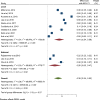Role and effectiveness of telephone hotlines in outbreak response in Africa: A systematic review and meta-analysis
- PMID: 38019849
- PMCID: PMC10686465
- DOI: 10.1371/journal.pone.0292085
Role and effectiveness of telephone hotlines in outbreak response in Africa: A systematic review and meta-analysis
Abstract
Background: In Africa, little is known about the role of telephone hotlines in outbreak response. We systematically reviewed the role and effectiveness of hotlines on outbreak response in Africa.
Method: We used the Cochrane handbook and searched five databases. The protocol was registered on PROSPERO (CRD42021247141). Medline, Embase, PsycINFO, Global Health and Web of Science were searched from 30 June 2020 to August 2020 for studies on the use of telephone hotlines in outbreak response in Africa published between January 1995 and August 2020. The search was also repeated on 16 September 2022. Data on effectiveness (alerts generated, cases confirmed) were extracted from peer-reviewed studies. Meta-analysis of alerts generated, and proportion of cases confirmed was done using the random effects model. The quality of studies was assessed using the Joanna Briggs Institute (JBI) tools. The heterogeneity and publication bias were assessed using the Galbraith and funnel plots, respectively.
Results: Our search yielded 1251 non-duplicate citations that were assessed. 41 full texts were identified, and 21 studies were included in the narrative synthesis, while 12 were included in the meta-analysis. The hotlines were local (seven studies) or national (three studies). A combination of a local and national hotline was used in one study. The hotlines were set up for unusual respiratory events (one study), polio (one study), Ebola (10 studies), COVID-19 (two studies), malaria (one study), influenza-like illnesses (ILI) (one study) and rift valley fever in livestock (one study). Hotlines were mainly used for outbreak surveillance at the local level. A total of 332,323 alerts were generated, and 67,658 met the case definition, corresponding to an overall pooled proportion of alerts generated(sensitivity) of 38% (95%CI: 24-52%). The sensitivity was 41% (95% CI: 24-59%) for local hotlines and 26%(95%CI:5-47%) for national hotlines. Hotlines were also used for surveillance of rift valley fever in livestock (one study) vaccination promotion (one study), death reporting (five studies), rumour tracking and fighting misinformation (two studies) and community engagement (five studies). The studies were of low to moderate quality with high publication bias and heterogeneity(I2 = 99%). The heterogeneity was not explained by the sample size.
Conclusion: These data suggest that telephone hotlines can be effective in outbreak disease surveillance in Africa. Further implementation research is needed to scale up telephone hotlines in rural areas.
Copyright: © 2023 Fongwen et al. This is an open access article distributed under the terms of the Creative Commons Attribution License, which permits unrestricted use, distribution, and reproduction in any medium, provided the original author and source are credited.
Conflict of interest statement
The authors have declared that no competing interests exist.
Figures




Similar articles
-
Beyond the black stump: rapid reviews of health research issues affecting regional, rural and remote Australia.Med J Aust. 2020 Dec;213 Suppl 11:S3-S32.e1. doi: 10.5694/mja2.50881. Med J Aust. 2020. PMID: 33314144
-
Contemporary epidemiological data of Rift Valley fever virus in humans, mosquitoes and other animal species in Africa: A systematic review and meta-analysis.Vet Med Sci. 2023 Sep;9(5):2309-2328. doi: 10.1002/vms3.1238. Epub 2023 Aug 7. Vet Med Sci. 2023. PMID: 37548116 Free PMC article.
-
Exploring the cost-effectiveness of child dental caries prevention programmes. Are we comparing apples and oranges?Evid Based Dent. 2020 Mar;21(1):5-7. doi: 10.1038/s41432-020-0085-7. Evid Based Dent. 2020. PMID: 32221482
-
Paving the way for human vaccination against Rift Valley fever virus: A systematic literature review of RVFV epidemiology from 1999 to 2021.PLoS Negl Trop Dis. 2022 Jan 24;16(1):e0009852. doi: 10.1371/journal.pntd.0009852. eCollection 2022 Jan. PLoS Negl Trop Dis. 2022. PMID: 35073355 Free PMC article.
-
Selected wetland soil properties correlate to Rift Valley fever livestock mortalities reported in 2009-10 in central South Africa.PLoS One. 2020 May 18;15(5):e0232481. doi: 10.1371/journal.pone.0232481. eCollection 2020. PLoS One. 2020. PMID: 32421747 Free PMC article.
References
-
- Owusu-Agyei S, Okafor G, Chijoke-Mgbame AM, Ohalehi P, Hasan F. Internet adoption and financial development in sub-Saharan Africa. Technol Forecast Soc Change [Internet]. 2020;161(August):120293. Available from: 10.1016/j.techfore.2020.120293. - DOI
-
- Global System for Mobile Communications Association(GSMA). The Mobile Economy. Sub-Saharan Africa. 2020. [Internet]. 2020. Available from: https://www.gsma.com/mobileeconomy/wp-content/uploads/2022/10/The-Mobile....
-
- Bahia K, Delaporte A. The State of Mobile Internet Connectivity 2020. GSMA Reports [Internet]. 2020;61. Available from: https://www.gsma.com/mobilefordevelopment/wp-content/uploads/2019/07/GSM....
-
- Kondowe R. “I did it all on a phone”: The hotline changing health outcomes in Malawi. African Arguments [Internet]. 2022; Available from: https://africanarguments.org/2022/11/i-did-it-all-on-a-phone-the-hotline....
Publication types
MeSH terms
LinkOut - more resources
Full Text Sources
Medical
Miscellaneous

